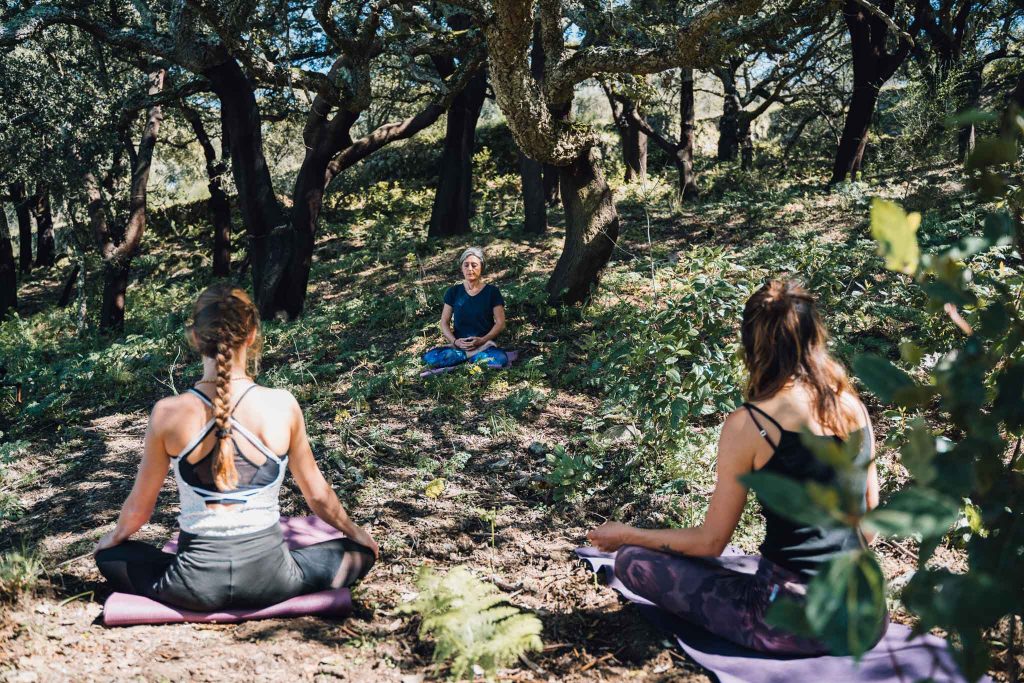1. The Doing
Sitting Meditation in Yoga in the beginning is pure activity. It involves you being in a certain place for a certain amount of time and usually in a certain posture.
At first you observe your whole body from the Inside. I often ask my students to do a kind of Body Scan checking on any discomfort. To sit means to be as comfortable as possible and that sometimes means that we may need something to sit on, a cushion or a block, at times you sit on a chair if necessary. The more comfortable you are, the better it is.
Simply sitting is a difficult practice
You simply sit with nothing. You try to judge your sitting. You think about if it is good or bad. Don´t try to understand your thoughts nor control your doing. Everything is ok.
We always want to grasp at something. Be aware of that. When this urge occurs, return to the awareness of your body, to your breath, to the way you are seated, to your posture.In the beginning when we sit many thoughts arise. There is no use in trying to delete them. Simply ask to remain present keeping your posture stable connecting again with your body & breath.
Speaking for myself I can still quite well feel, how much I do , how much I concentrate (ME, the subject, who concentrates) on the object of concentration (Body & Breath & other points of concentration in the body).
In Yoga we call it the „Seer“ (ME) and the „seen“(object) .There is a „ME“ who is aware or attentive of „binding the mind to a place“ . This Doing is called: Dhāraṇā, a purely mental process.
2. The Not-Doing
The not-doing of Sitting (meditative state of mind) is not bound to location, posture, activity or time. It is not something that you „do“ but something that you „are“. There is no object of attention (e.g.Breath or Body ) and no subject (ME) that pays attention, but only the state of attention itself, without object and subject. This is total attention, not to something in particular, but all around, to everything, In this there is complete silence. There is no ME“who is aware or attentive. This Not-Doing is called dhyāna, , the Seer entering the being of the mediation object.
Dhāraṇā ( concentration) is binding consciousness to a place. (III.1, Patanjalis Yoga Sutras)

3. Pure Bliss
When the mind and the act of meditation on the point are forgotten completely ,and the only point or the object that´s looked at is present. Sticking to the example of the „Seer“ and the „seen“. The „Seer“ is now the very form of the object the „seen“. That´s Samadhi.
The Three together (Concentration, Meditation & Samadhi)” – Samyama.” Patanjali´s Yoga Sutras III 4.
Struggles
If someone has pain while sitting crossed legs, it´s better to straighten the legs, or sit in any other position which is comfortable, in order not to hurt oneself during a time of „not moving“.
If sitting becomes a „torture“, that means we are strongly challenged on an emotional level, it is better to release the legs and to rest. Sometimes lying for a short time on the back allow us to continue. A constant battle of our Ego and ambition is of no use.
ME on Sitting
Speaking for myself the more I sit, the more I look, the more I see. The more subtle and fine my seeing becomes & the more it influences and has an effect on my daily life and my practice.
Sitting for me has become a daily practice. It allows me to see things from a distance and to identify less with all that happens to me; situations, thoughts and feelings. My mind is more calm and at ease, even though thoughts don´t disappear completely. It is that one place I want to be, every day 🙂
There is always a sense of I-am-ness and that is for the time being ok but more and more I am able to see the light on which the thoughts reflect on, which helps me purifying my mind. At least that is the feeling I have, hopefully not an illusion ;-).
Let´s Meet & Sit together
- Ongoing classes in the Studio and on the Beach


